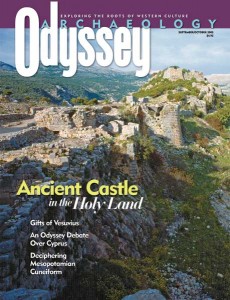Archaeology Odyssey, September/October 2005
Features
Guarding the Holy Land
Who Built the Nimrud Fortress?
Nimrud is the largest and most perfectly preserved Crusader-period fortress in Palestine. It sits on the southern slopes of Mount Hermon, in present-day northern Israel, on a north-south ridge of a deep gorge. H.H. Kitchener (1850–1916)—a British engineer who conducted an archaeological survey in...Read more ›
Saved from Vesuvius
Rare Wooden Furniture from Pompeii and Herculaneum
Herculaneum and Pompeii were both destroyed by the same eruption of Mount Vesuvius in 79 A.D. For archaeologists, however, it must seem that they were leveled by different volcanoes entirely. Pompeii was smothered beneath a shallow blanket of volcanic pebbles (lapillae) and dust. It has been relatively...Read more ›
Don’t Be Fooled!
Despite what many scholars say, ancient “Alashiya” was not Cyprus
For some decades now the scholarly world has been perpetuating a scam, one that has several times duped the editors of Archaeology Odyssey. In “The Last Days of Hattusa,”a for example, Trevor Bryce quotes an ancient letter from the king of Ugarit (modern Ras Shamra on Syria’s...Read more ›
Cyprus & Alashiya
One and the same!
The following letter recently surfaced in the antiquities collection of a noble European family and is published here for the first time. The brackets indicate illegible text that has been restored by the translator.—Ed. [Say] to the [goo]d Ambassador [Rob]ert Merrillees, my fath[er]: message of E[ric] Cline,...Read more ›
Alashiya Rejoinder
If there is one benefit to be derived from the ongoing dispute over the location of ancient Alashiya, it is the production of new data, such as the previously unknown letter, in alphabetical English, from a well-reputed scribe, which Archaeology Odyssey has now published for the first...Read more ›

